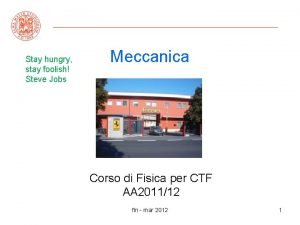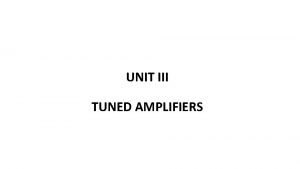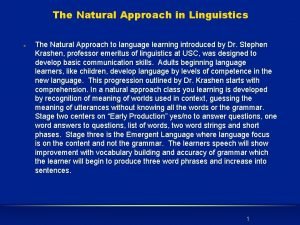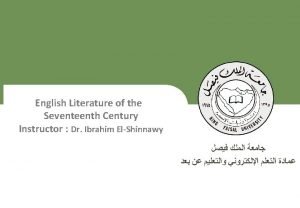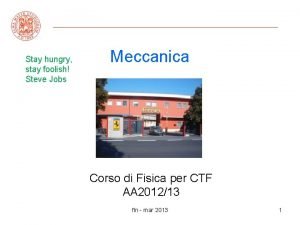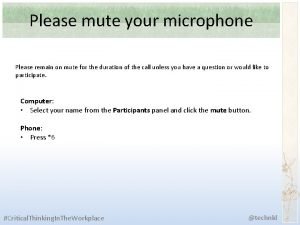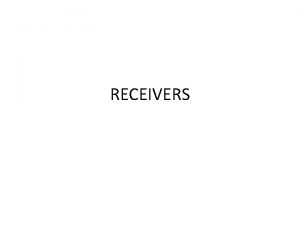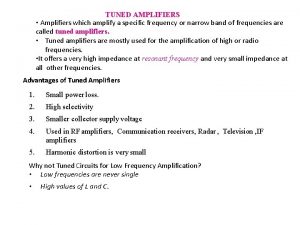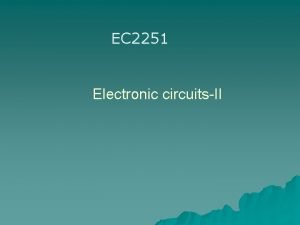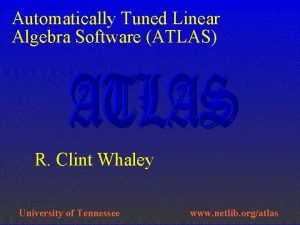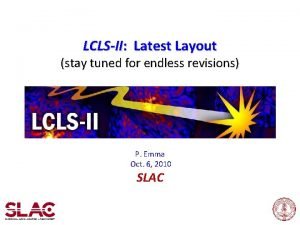v PLEASE STAY TUNED TO THE SPEAKER Acknowledgements





























- Slides: 29

v. PLEASE STAY TUNED TO THE SPEAKER Acknowledgements 20 -Sep-21 1

Measurements & Instrumentation – 2 A Presentation / Talk By Dr. J. S. Saini Prof. , EED; Dean, Faculty of Engg. & Tech. , D. C. R. Univ. of Sci. & Tech. , Murthal, Sonipat Ph. : 9416351300, 9416354914, Email: jssain@rediffmail. com Reference: J. S. Saini, “Textbook of Measurements and Instrumentation (With Laboratory Experiments)” As per AICTE Model Curriculum 9/20/2021 Pub. : New Age Publishers, New Delhi.

CONTENTS MEASURING INSTRUMENTS 1. MOTIVATION 2. MOVING COIL INSTRUMENT 2. 1 PERMANENT MAGNET MOVING COIL (PMMC) TYPE 2. 1. 1 Operating Principle 2. 1. 2 Constructional Features 2. 1. 3 Torque Equation 2. 1. 4 Shape of the Scale 2. 1. 5 Use as D. C. Ammeter or as D. C. Voltmeter (Extension of Range): 2. 2 ELECTRODYNAMIC (ELCTRODYNAMOMETER) TYPE 2. 2. 1 Construction (more to follow) 3. MOVING IRON INSTRUMENT (IRON-VANE INSTRUMENT) 3. 1 3. 2 3. 3 3. 4 CLASSIFICATION OF MOVING IRON (M. I. ) INSTRUMENTS ATTRACTION TYPE (OR SINGLE IRON TYPE) REPULSION TYPE (DOUBLE IRON TYPE) COMBINED ATTRACTION-REPULSION TYPE 3. 4. 1 Basic Principle and Construction 3. 5 3. 6 3. 7 3. 8 GENERAL TORQUE EQUATION SHAPE OF SCALE ADVANTAGES OF M. I. INSTRUMENTS DISADVANTAGES OF M. I. INSTRUMENTS 20 -Sep-21 Dr. J. S. Saini, Prof. , EED; Dean, Faculty of Engg. & Tech. , Ph. : 9416351300, Email: jssain@rediffmail. com 3

MEASURING INSTRUMENTS 1. MOTIVATION • Diff. instruments are better suited for diff. applications. • Instruments augment / enhance the faculties / capabilities of human beings. • For all applications, guiding principle: measuring device, by defn. is meant only to measure & not to load /change /modify the measurand (qty. to be measured). • So, impedance (Z) or resistance (R) of instrument & its connection to circuit (in which measurements are to be made) should be such (in fact, high) that existing circuit conditions aren’t changed. • For the same season, power consumed by a measuring instrument should be small, else instrument will cause loading on the Dr. J. S. Saini, Prof. , EED; Dean, Faculty of Engg. & Tech. , 20 -Sep-21 4 measurand. Ph. : 9416351300, Email: jssain@rediffmail. com

2. MOVING COIL INSTRUMENT • 20 -Sep-21 Dr. J. S. Saini, Prof. , EED; Dean, Faculty of Engg. & Tech. , Ph. : 9416351300, Email: jssain@rediffmail. com 5

Fig. 1(a) Suspension Type (Laboratory Type) PMMC (D’Arsonval) Movement; (b) Light-beam and mirror arrangement 20 -Sep-21 Fig. 2 Pivot & Bearing Type (Portable Type) PMMC Dr. J. S. Saini, Prof. , EED; Movement. Dean, Faculty of Engg. & Tech. , (D’Arsonval) Ph. : 9416351300, Email: jssain@rediffmail. com 6

Fig. 1 is more popularly called D’Arsonval movement & Fig. 2 is known as PMMC movement. • As galvanometer normally designed to have higher sensitivities than other instruments (like ammeters, voltmeters, etc. ), so D’Arsonval movement quite often used for sensitive galvanometers & PMMC movement is commonly used for less sensitive ammeters & voltmeters. 2. 1. 2 Constructional Features: • We deal with only the moving coil and the core, the other constructional features touched upon in other sections (3. 5 and 2. 6 sections of chapters-3 & 2). • MOVING COIL & THE CORE: • Moving coil is made of many turns of enamelled or silk-covered copper wire; aluminum wire can be used to reduce weight & inertia. • Coil: wound on an insulated former/ frame/ bobbin of a light nonmagnetic material. • Normally, voltmeter coils: wound on metallic formers to provide electromagnetic damping. Ammeter coils: wound on non-metallic 20 -Sep-21 7 J. S. Saini, Prof. , EED; Dean, Faculty of Engg. &ammeter Tech. , formers as coil. Dr. turns are effectively shorted by shunt &, so, Ph. : 9416351300, Email: jssain@rediffmail. com

fragile coil. • Normally, rectangular coils used; accordingly bobbin is also of rectangular shape. • But, sometimes long sides (A & B of Fig. 3 b) of the former (frame) are curved to a radius so as to make the coil concentric with core & hence to make air gap (b/n magnet & core) minimum & uniform. The air gap is typically 1 mm radially. Fig. 3 Coil and Former / Bobbin Shapes • Fixed soft iron core (armature) is placed concentrically with pole faces. Core: spherical if shape of coil is circular but core is cylindrical if coil is rectangular. Fn. of core: provide a low reluctance to flux path & ensure greater strength of magnetic field for the coil. 20 -Sep-21 Dr. J. S. Saini, Prof. , EED; Dean, Faculty of Engg. & Tech. , Ph. : 9416351300, Email: jssain@rediffmail. com 8

2. 1. 3. Torque Equation: Dimensions of a PMMC instrument are as in Fig. 4: Fig. 4 Dimensions of a PMMC instrument. 20 -Sep-21 Dr. J. S. Saini, Prof. , EED; Dean, Faculty of Engg. & Tech. , Ph. : 9416351300, Email: jssain@rediffmail. com 9

α = angle between the direction of magnetic field and the active coil side. This angle is 90° since the field is radial and active coil side is vertical and it moves within the radial field region (i. e. , it moves within the pole-arcs). = Ni. AB Newton metre (1) Since N, A, B are constants for a given instrument, where G = NBA is ‘instrument constant’. If spring control (usually used in PMMCs) is used, then controlling torque is: where Ki = K/G = a constant 20 -Sep-21 Dr. J. S. Saini, Prof. , EED; Dean, Faculty of Engg. & Tech. , Ph. : 9416351300, Email: jssain@rediffmail. com 10

2. 1. 4 Shape of the Scale: • From =n 4, in a spring controlled PMMC instrument, deflection is proportional to current passing through meter & so such an instrument has a uniform scale (provided, of course, current being measured is directly passed through meter). • Uniform scale holds good only if deflecting torque is independent of deflection, θ (as indicated by =n 1) which is ensured by having a uniform air gap & a radial field. • But if flux distribution is uneven in air gap (due to, say, eccentric core or specially shaped pole faces), scale will be non-uniform. • If qty. being measured is not proportional to current passed thro’ meter, scale is again non-uniform (provided, of course, that air gap is uniform & field is radial). • E. g. , if quantity being measured is heat, which is proportional to I 2, then heat ∝ θ 2 (as θ ∝ I), thus scale will be cramped at lower end. 20 -Sep-21 Dr. J. S. Saini, Prof. , EED; Dean, Faculty of Engg. & Tech. , Ph. : 9416351300, Email: jssain@rediffmail. com 11

Range): • PMMC instrument: the most accurate for D. C. measurements. • Can’t measure A. C. as torque depends upon dir. of current. At very low freq. A. C. (< 1 Hz), pointer oscillates with freq. of current, but, at higher frequencies (say, 50 Hz or more), inertia of moving system prevents the pointer from moving at all in either dir. • Coil of basic PMMC meter instrument has ltd. current carrying capacity, say, it can safely carry current upto ≈ 20 m. A. To measure currents usually, > 20 m. A, shunt is connected across moving coil (Fig. 5) to bypass a major portion of total current. • A shunt is a low resistance (tube / strip / wire) connected across the meter circuit. • Galvanometer (note: galvanometer scale, is marked, but not calibrated) can read very small currents by calibrating its scale, so converting it into a micro- or milli-ammeter. But, range can be Dr. J. S. Prof. , EED; Dean, Faculty ofan Engg. & Tech. , extended of. Saini, shunts, thus making ammeter. 20 -Sep-21 by use 12 Ph. : 9416351300, Email: jssain@rediffmail. com

Fig. 5 Basic PMMC meter in conjunction with a shunt to form an ammeter. Fig. 6 Basic PMMC meter in conjunction with a multiplier to form a voltmeter. Similarly, basic PMMC meter can read micro or milli volts by calibrating its scale in micro or millivolts. But, to convert it into a voltmeter (capable of reading >100 m. V, say), suitable high resistance (called multiplier) to be connected in series with meter (Fig. 6). 20 -Sep-21 Dr. J. S. Saini, Prof. , EED; Dean, Faculty of Engg. & Tech. , Ph. : 9416351300, Email: jssain@rediffmail. com 13

2. 2 ELECTRODYNAMOMETER (OR DYNAMOMETER OR ELECTRODYNAMIC) MOVING COIL TYPE: • Motivation for studying this instrument comes from following 4 facts: • It has two independent ckts. (thus 2 independent i/ps to movement) that permit its use in diff. applications such as I-, V-, W-, VAR-meters, p. f. meters and freq. meters. • To calibrate all indicating type instruments, standards of V and R reqd. As available standard of voltage, i. e. , Weston Standard Cell, is a D. C. cell, so, impossible to calibrate an A. C. instrument directly against fundamental standards. • Need arises of instrument (called ‘transfer instrument’) equally accurate on both A. C. & D. C. The Electrodynamic instrument, is an ideal ‘transfer instrument (separte sec. ) • PMMC can’t measure A. C. , but electrodynamic instrument can measure both A. C. (since product of two –ve currents yields +ve qty. ) & D. C. 20 -Sep-21 Dr. J. S. Saini, Prof. , EED; Dean, Faculty of Engg. & Tech. , Ph. : 9416351300, Email: jssain@rediffmail. com 14

2. 2. 1 Construction: • Its construction similar to that of PMMC instrument, except: in PMMC, air gap flux produced by permanent magnet, in the electrodynamic instrument, it is produced by an air-cored electromagnet. • Electromagnet is made of an air-cored fixed coil (called field coil) which carries current from (or a current proportional to) the qty. being measured. • Fixed coil in 2 sections (2 coils) to give uniform field near centre of these 2 coils & to allow a moving coil (again air-cored) to be housed at centre; fixed coils spaced far apart to allow passage of shaft of movable coil as in Fig. 7. Schematic: Fig. 8. Fig. 7 Electrodynamic Instrument 20 -Sep-21 Fig. 8 Schematic diagram of electrodynamic movement. … More to follow 15 Dr. J. S. Saini, Prof. , EED; Dean, Faculty of Engg. & Tech. , Ph. : 9416351300, Email: jssain@rediffmail. com

both on A. C. & D. C. , but expensive. M. I. instruments work on A. C. or D. C. , are inexpensive, rugged & can be constructed to give accuracy required for most engg. applications. • Their use at power frequencies is particularly attractive. These instruments, thus, find common use in labs. & switch-boards at power frequencies. 3. 1 CLASSIFICATION OF MOVING IRON (M. I. ) INSTRUMENTS • M. I. instruments classified into 2 groups: (a) Attraction Type & (b) Repulsion Type. Features of attraction & repulsion type combined: Attraction-Repulsion Type. • In actual measurements, only repulsion type or combined attractionrepulsion type are used (for reasons: comparatively economic production & wider scale). But, attraction type lends ease of understanding. 3. 2 ATTRACTION TYPE (OR SINGLE IRON TYPE) : • BASIC PRINCIPLE & CONSTRUCTION: • If a piece of un-magnetized soft iron (of high permeability) is brought near either of Dr. two ends of a current-carrying coil (electromagnet), 16 it 20 -Sep-21 J. S. Saini, Prof. , EED; Dean, Faculty of Engg. & Tech. , Ph. : into 9416351300, Email: would be attracted the coil in jssain@rediffmail. com same manner as it would be

• The electromagnet carries either current to be measured (or part thereof) or a current proportional to voltage to be measured. • Very basic set-up of Fig. 9 demonstrates the above principle. • As current, I, to be measured, is passed thro’ the coil, the soft iron core is pulled into the stronger magnetic field inside the coil so as to increase the flux of electromagnet. • This is because soft iron piece tries to occupy a position of minimum reluctance (or maximum inductance for the coil). Pointer deflection is controlled by a spring. Fig. 9 Basic set-up to demonstrate principle of operation of Attraction Type Moving Iron Instrument. • Let, I, be reversed in dir. ; core still attracted inside electromagnet, as a soft magnetic material, was not permanently magnetized due to previous flow of current in coil. • Thus an ‘unpolarized’ instrument, i. e. , independent of direction of current passing through it. Hence, such instruments can be used for D. C. as well as for A. C. 20 -Sep-21 Dr. J. S. Saini, Prof. , EED; Dean, Faculty of Engg. & Tech. , Ph. : 9416351300, Email: jssain@rediffmail. com 17

• In actual practice, basic set-up (Fig. 9) rarely used as its primitive construction �it prone to outer vibrations and accelerations which restrict its sensitivity. However, it is used for voltage testers, just to distinguish line voltage from phase voltage, such as 220 V from 400 V etc. • Consider a more practical construction as in Fig. 10 Construction of Attraction Type Moving Iron Instrument. • Coil of insulted Cu wire wound on a non-metallic hollow bobbin to give flatshaped solenoid. • Soft iron moving element (a thin oval-shaped disc) eccentrically mounted on a spindle just outside solenoid such that greatest bulk of disc moves, on deflection, into center of solenoid. • Spindle pivoted, at the ends, b/n bearings (not shown in sectional view of Fig. 10). 18 Dr. J. S. to Saini, Prof. , EED; Dean, Faculty of Engg. & Tech. , (for gravity control) • Al 20 -Sep-21 pointer attached spindle. Non-metallic control-wts. Ph. : 9416351300, Email: jssain@rediffmail. com & balance-wts. attached to 2 arms fixed to spindle. Gravity control (as in

• Since neither permanent magnet nor moving non-magnetic metallic disc forms a part of operating sys, so, eddy current damping ≠ right choice for such instruments. Air friction damping used which uses a light Al piston moving in a sector-shaped chamber. • All inner system components consist of non-magnetic materials except for soft-iron vanes. This ensures a very symmetrical coil field. • Construction of Fig. 10 has following improvements over primitive construction of Fig. 9: Eccentric mounting of moving element allows its rotational motion (instead of linear motion), thus achieving immunity against linear accelerations, which are usually encountered ones such as for meters installed on vehicles etc. Solenoid is flat-shaped, it gives a concentrated field with minimum energy expenditure. • Moving element is a thin disc, it allows a significant bulk (area) of iron to be attracted into solenoid (so developing a substantial torque) & at same time keeps moving sys. light in wt. • We digress to discuss basic principle & construction of other 2 types of M. I. instruments: 20 -Sep-21 3. 3 Dr. J. S. Saini, Prof. , EED; Dean, Faculty of Engg. & Tech. , Ph. : 9416351300, Email: jssain@rediffmail. com REPULSION TYPE (DOUBLE IRON TYPE): 19

+ – Coil S A C S S N Soft N N iron B D rods Fig. 11 Basic set-up to demonstrate the principle of Instruments operation of Repulsion Type a) Radial Vane Type b) Co-axial (Concentric) Vane Type. • Basic principle of repulsion type instruments illustrated with basic set-up of Fig. 11. • As current flows through coil, 2 soft iron rods (placed in parallel) are magnetized with similar polarity at all sections. Adjacent ends, i. e. , A & C turn S-poles; ends B & D become N-poles (for coil-current direction as shown). So, two bars will repel each other. • Diagonally opposite ends, i. e. , A & D and also ends B & C (being of opposite polarities) tend to attract each other, but being far off, don’t contribute significantly to net repulsion process. • If coil current is reversed, polarity of both magnetized rods is reversed, so again repel. 20 -Sep-21 20 J. S. Saini, Prof. , EED; Dean, to Faculty of Engg. & Tech. , force can be made • Now, if one bar. Dr. fixed & other is free move, repulsion Ph. : 9416351300, Email: jssain@rediffmail. com

Two sub-types (designs) of repulsion type instruments are now discussed. (a)RADIAL VANE TYPE: Vanes placed radially within coil (Fig. 12). Fixed vane attached to coil/ bobbin & movable one to spindle. Repelled, movable vane moves along circular arrow (12 b). (b) CO-AXIAL (CONCENTRIC) VANE TYPE: Fig. 13: fixed & movable vanes: sections of co-axial cylinders; when developed, assume shapes as in Fig. 14. • Moving vane moves co-axially inside static tapered (tongue-shaped) vane, keeping same radial distance, d, (Fig. 4. 22 b) but torque results as wider portion (end B: Fig. 14) of fixed vane produces a stronger repulsive force compared to that by thinner portion (end A). So, movable vane moves in direction of taper. Fig. 12 Radial Vane Type (a) Front Section View Fig. 13 Co-axial Vane Type (a) Front Section View 20 -Sep-21 21 Dr. J. S. (b) Saini, Prof. , EED; Dean, Faculty of Engg. & Tech. , (b) Plan View Ph. : 9416351300, Email: jssain@rediffmail. com

Fig. 14 Developed view of Fixed & Movable Co-axial vanes. 3. 4 Combined Attraction-Repulsion Type: • BASIC PRINCIPLE AND CONSTRUCTION: Prac. designs of attraction type & repulsion type limited: give deflections not more than ≈100°. Range extended to 240° by combining, in a single meter, the features of both repulsion type & attraction type instruments. • Such meter also called ‘Long-scale’ / ‘Circular scale’ instrument (Fig. 15). Diff. vanes (3 fixed & 1 movable), when developed, assume shapes as in Fig. 16. • Attraction feature not exploited in sense of Fig. 10, i. e. , no vane mounted outside solenoid gets attracted into it. Rather, 2 concentric (co-axial) tapered vanes used (attraction vanes), whose taper ↑es as taper of middle vane (repulsion vane) ↓es. So, middle vane: just same as co-axial (concentric) vane of repulsion type. • In lower portion of scale, movable vane mainly confronted by fixed middle 20 -Sep-21 22 J. S. Saini, Prof. , EED; Engg. &of. Tech. , vane (wider in. Dr. this region). So, Dean, in Faculty lowerof part scale, movable vane Ph. : 9416351300, Email: jssain@rediffmail. com experiences mainly repelling force. As deflection ↑es, outer stationary

Fig. 15 Combined attraction-repulsion type (front section view). Fig. 16 Developed view of one movable and three fixed vanes. 3. 5 GENERAL TORQUE EQUATION • Let initial current (instantaneous) in instrument be ‘i’ Amp. , instrument inductance L Henry & deflection θ radians. • Let applied voltage be increased by ‘e’ volts above zero which results in increment di in current, dθ in deflection & d. L in inductance. 20 -Sep-21 Dr. J. S. Saini, Prof. , EED; Dean, Faculty of Engg. & Tech. , Ph. : 9416351300, Email: jssain@rediffmail. com 23

Now, electrical energy supplied = (voltage)x(current)x(time increment) So, Incremental energy supplied = (incremental voltage)x(current)x(time increment) = eidt which, by using =n 5, becomes: i 2 d. L + i. Ldi stray capacitance neglected (this assumption (6) not justified at Now, =assuming: high frequencies), �energy stored in electric field neglected, so energy stored only in magnetic field as (½)Li 2. For the case at hand, the energy stored changes from (½)Li 2 to (½)(L + d. L)(i + di)2. 2 + 2 idi + di 2) – (½)Li 2 (neglect di 2) So, Change 2 in stored energy 2 = (½)(L + d. L)(i 2 = (½)Li + Li di + (½)(d. L)i + I di d. L – (½)Li (neglect I di d. L ) = Li di + (½)i 2 d. L (7) For circular motion, mechanical work done = Torque x angular displacement (just as for linear motion, Work done = Force x covered distance) So, Mechanical work done = (τd)idθ (8) Where (τd)i = instantaneous deflecting torque in N-m. From the principle of conservation of energy, Incremental energy supplied = Increase in stored energy + Mechanical work done So, using Eqns. 6 to 8, we have: …Faculty of Engg. & Tech. , Dr. J. S. Saini, Prof. , EED; Dean, 20 -Sep-21 Ph. : 9416351300, Email: jssain@rediffmail. com 24

i 2 d. L + i. Ldi = Li di + (½)i 2 d. L + (τd)idθ So, (τd)idθ = (½)i 2 d. L Or, (τd)i = (½)i 2(d. L/dθ) (9) Instantaneous torque is a function of square of instantaneous current & will, therefore, have a non-zero +ve average value. It is a mathematical proof that M. I. instruments can be used on D. C. as well as on A. C. Case-I Use on D. C. : In this case, i = Idc = steady D. C. current = I (say) So, Average torque = (τd)av = (½)I 2(d. L/dθ) (10) Case-II Use on Sinusoidal A. C. : The Average torque = (τd)av = (1/T) dt where T = Time period of one cycle. So, (τd)av = (1/2)(d. L/dθ) As term in square bracket ⟹, by defn. , the square of RMS value of A. C. current, So, (τd)av = (½)I 2(d. L/dθ) (11) Where I = RMS value of A. C. current. As pointed earlier, spring control is normally used, we have controlling torque, 20 -Sep-21 Dr. J. S. Saini, Prof. , EED; Dean, Faculty of Engg. & Tech. , Ph. : 9416351300, Email: jssain@rediffmail. com 25

τc = Kθ where K = spring constant; N-m/rad & θ = deflection in rad. At equilibrium (final steady) position, τc = τd So, Kθ = (½)I 2(d. L/dθ) Or, Deflection, θ = (½)(I 2/K)(d. L/dθ) (12) So, steady deflection is a fn. of sq. of rms value (D. C. value in case D. C. ) of current. 3. 6 SHAPE OF SCALE • General torque =n. 9 or general scale =n. 12 applicable to any type of M. I. instrument. In general ⟹ deflecting torque or, deflection (for spring controlled M. I instrument) is proportional to square of instrument current & rate of change of inductance with deflection. • [Note: In attraction type, ↑ in inductance with ↑ in deflection is due to change in extent to which the iron is within the coil; & in repulsion type, it is due to ↑ of flux by a ↓ in demagnetizing effect of one iron on the other as two irons move apart. ] • If no saturation, L is a const. times θ [Note: Due to assumptions in derivation, not reflected in torque eqn. , L not only depends upon θ, but also upon I due to presence of ferromagnetic material (moving iron). ] i. e. , rate of change of L with θ is constant, then a ‘square-law’ scale results, i. e. , J. S. Saini, Prof. , EED; Dean, Faculty of Engg. & Tech. , 20 -Sep-21 26 graduations in Dr. lower of Email: scalejssain@rediffmail. com are crowded & at higher side spread Ph. : portion 9416351300, out.

• LINEARISATION OF SCALE: • Clue to linearization of scale lies in the scale Eqn. itself (i. e. , Eqn. 12). • A linear scale possible if (d. L/dθ) is made an inverse function of I or else(d. L/dθ) is made an inverse function of θ 3. 7 ADVANTAGES OF M. I. INSTRUMENTS n due a) Robust parts. b) Can be used both for A. C. & D. C. , although not with the same accuracy. c) Less prone to frictional errors due to their high torque to wt. ratio & as their moving system can be made light (because not to carry any current). d) No current-carrying moving parts, so identical moving sys’s may be used for an entire range of instruments, thus M. I. instruments can be produced at less cost. Possible because for a given displacement of moving sys. (i. e. , to produce a given m. m. f. ), either a coil of a few turns of thick cross section, or a coil with large number of turns of thin cross section may be used. e) Attraction type M. I. instruments usually have lower L & hence more accurate over a wider range of frequency, as compared to repulsion type M. I. Dr. J. S. Saini, Prof. , EED; Dean, Faculty of Engg. & Tech. , 20 -Sep-21 27 instruments. Ph. : 9416351300, Email: jssain@rediffmail. com

3. 8 DISADVANTAGES OF M. I. INSTRUMENTS a) waveform changes, thus can’t be calibrated with D. C. & used on A. C. and vice-versa. They need to be calibrated separately for D. C. & separately for each frequency of A. C. at which they are used. b) Their scale is cramped at the lower end, giving less accurate readings at this range. 20 -Sep-21 Dr. J. S. Saini, Prof. , EED; Dean, Faculty of Engg. & Tech. , Ph. : 9416351300, Email: jssain@rediffmail. com 28

THANKS. ANY QUESTIONS PLEASE? Reference: J. S. Saini, “Textbook of Measurements and Instrumentation (With Laboratory Experiments)” As per AICTE Model Curriculum Pub. : New Age Publishers, New Delhi. 20 -Sep-21 Dr. J. S. Saini, Prof. , EED; Dean, Faculty of Engg. & Tech. , Ph. : 9416351300, Email: jssain@rediffmail. com 29
 What does stay hungry stay foolish mean
What does stay hungry stay foolish mean Stay tuned stay foolish
Stay tuned stay foolish Classification of tuned amplifier
Classification of tuned amplifier Characteristics of natural approach
Characteristics of natural approach Stay tuned examples
Stay tuned examples Too have
Too have Rascal flatts my wish
Rascal flatts my wish Good morning with stay safe
Good morning with stay safe Good afternoon stay safe
Good afternoon stay safe Stay hungry stay foolish significato
Stay hungry stay foolish significato So stay so stay 再知己
So stay so stay 再知己 Where you go i'll go where you stay ill stay
Where you go i'll go where you stay ill stay Please mute your microphone when not speaking
Please mute your microphone when not speaking Please be quiet. i (try) to sleep
Please be quiet. i (try) to sleep Tesol methodology
Tesol methodology Tuned amplifier ppt
Tuned amplifier ppt Taipei 101 damper
Taipei 101 damper Drawbacks of tuned radio receiver are
Drawbacks of tuned radio receiver are Classification of tuned amplifier
Classification of tuned amplifier Stagger tuned amplifier notes payable
Stagger tuned amplifier notes payable Clint whaley
Clint whaley Language learning miracles
Language learning miracles Roughly tuned input
Roughly tuned input Các châu lục và đại dương trên thế giới
Các châu lục và đại dương trên thế giới Tư thế worm breton
Tư thế worm breton Thế nào là hệ số cao nhất
Thế nào là hệ số cao nhất ưu thế lai là gì
ưu thế lai là gì Sơ đồ cơ thể người
Sơ đồ cơ thể người Tư thế ngồi viết
Tư thế ngồi viết đặc điểm cơ thể của người tối cổ
đặc điểm cơ thể của người tối cổ

